Posts Tagged: honeybee
Give Her Some Space
If you see a news story about "honey bees" in a newspaper or magazine, odds are you'll see it spelled as one word, ...
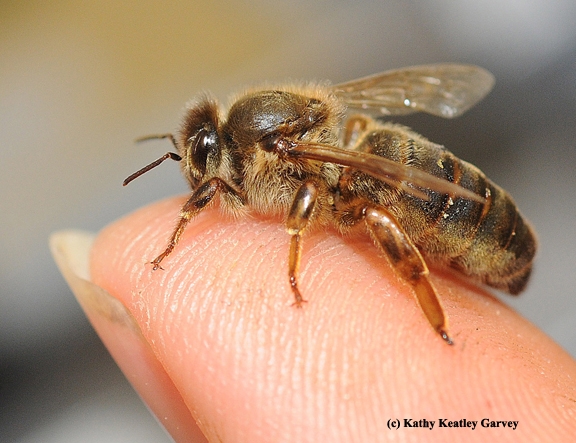
A honey bee queen on a finger. (Photo by Kathy Keatley Garvey)
A Honey of an Idea
Have you ever been out on a sunny day, walking barefoot happily through the clover when suddenly you yelp and begin to jump around trying to ease the sudden stinging pain in your foot? Yes, so have I. Well, the culprit is most likely the gentle little honeybee, one of nature's hardest working and least aggressive little beings. However, if a giant were going to step on me I'd use all my weapons to protect myself, too! Thus, the sad, negative reputation of the honeybee (Apis mellifera).
However, the honeybee is not only our friend, but also a very important part of our symbiotic natural family. According to National Geographic's most recent article (May 10, 2013), "About a third of our foods (some 100 key crops) rely on these insects, including apples, nuts, all the favorite summer fruits (like blueberries and strawberries), alfalfa (which cows eat), and guar bean (used in all kinds of products). In total, bees contribute more than $15 billion to U.S. crop production, hardly small potatoes." That's what makes the staggering disappearance of so many bees in the last few years such a troubling problem.
As you may have heard, during the winter of 2007 many beekeepers across the USA reported unusually large honeybee losses. The puzzling thing was that there were no piles of dead bees near the hives as happens if the bees are directly exposed to pesticides. It seems that the worker bees just began disappearing, leaving the queen and the young bees alone in the colony. However, the colony needs the worker bees to bring home the food and without them the hive and all the bees therein eventually dies. This is called Colony Collapse Disorder (CCD).
Over the years since that time studies have failed to conclusively identify the cause, but the result is that about 47% of the honeybees across the USA have been lost. (Figures from winter 2012-2013.) The EPA reports that several contributing factors are suspected:
- increased losses due to the invasive varroa mite (a pest of honeybees);
- new or emerging diseases such as Israeli Acute Paralysis virus and the gut parasite Nosema;
- pesticide poisoning through exposure to pesticides applied to crops bee management stress;
- foraging habitat modification
- inadequate forage/poor nutrition and
- potential immune-suppressing stress on bees caused by one or a combination of factors identified above.
What can we as gardeners do to help? We can, of course, avoid using pesticides in our gardens--especially neonicotinoids (approved for use in the US, but recently banned in the European Union). We can also provide a healthy and attractive habitat for honeybees. Enter the Yellow Dot Project (yellowdotproject.org). They not only publish a very extensive list of plants that are good food for honeybees, but also have connected with several nurseries in our area to identify for us exactly which plants on their shelves are best for the bees. Fantastic! All we have to do is look for the yellow dot on the plant i.d. marker. What could be easier?
I learned of the Yellow Dot Project on my visit to Annie's Annuals in Richmond last Saturday. Check out the website to see which plants in your garden are already at work helping the honeybees or just to find a "Yellow Dot" nursery to visit.
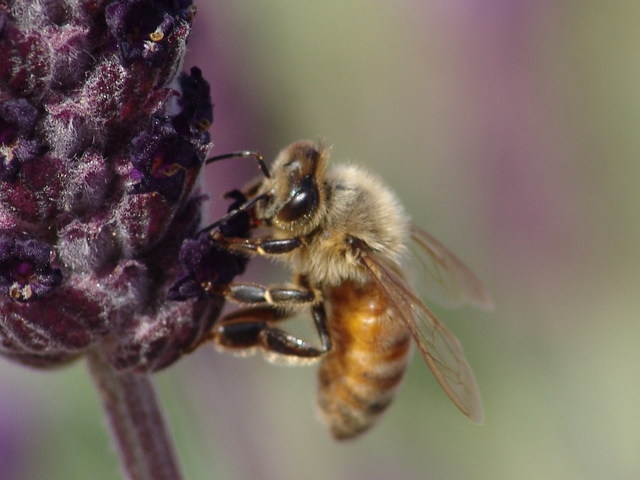
Honeybee on lavender. (photo by Thomas C. Tucker)
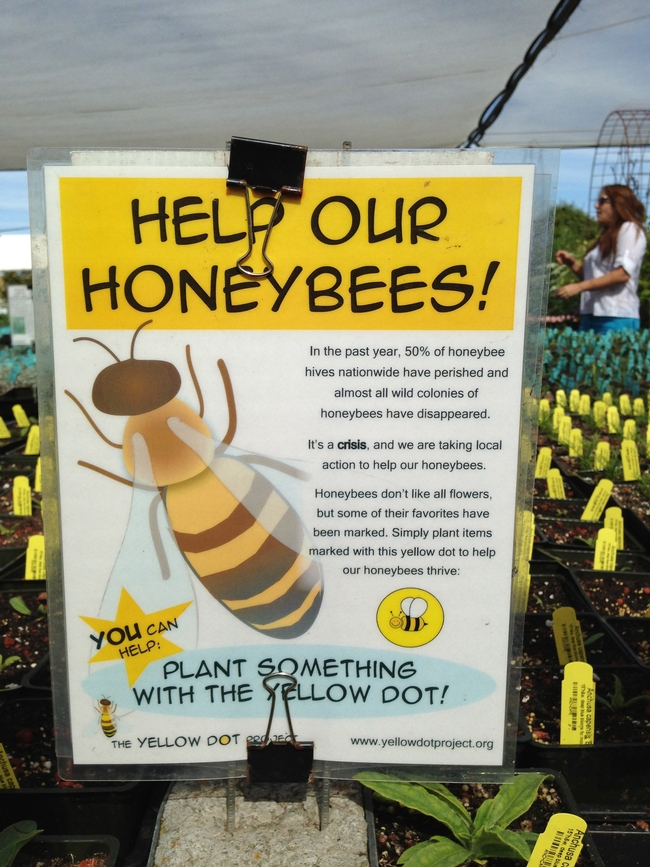
Help Our Honeybees. (photo by Marian Chmieleski)
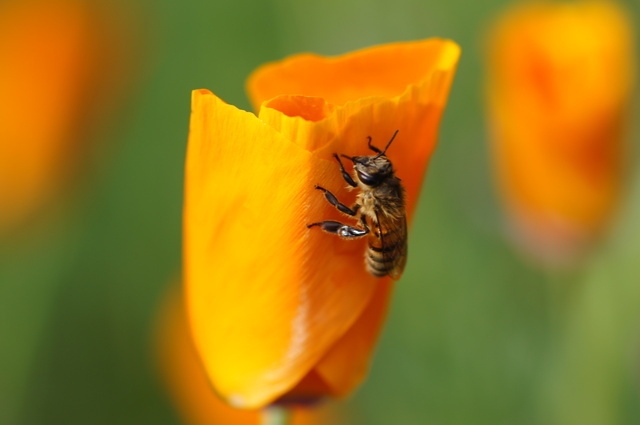
photo by Thomas C Tucker
The Sting
I've been asked how I did it. How did I manage to capture that rare image of a honey bee sting that won the feature photo award presented June 11 by...
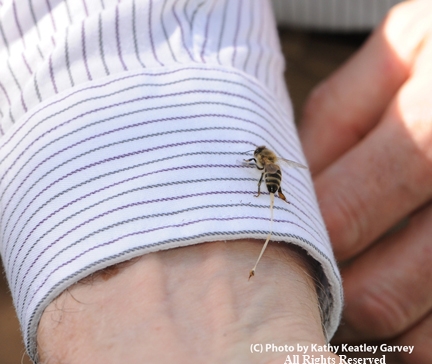
FIRST PHOTO--When honey bees sting, it's usually a clean break. Extension apiculturist Eric Mussen getting stung. (Copyrighted, All Rights Reserved, Photo by Kathy Keatley Garvey)
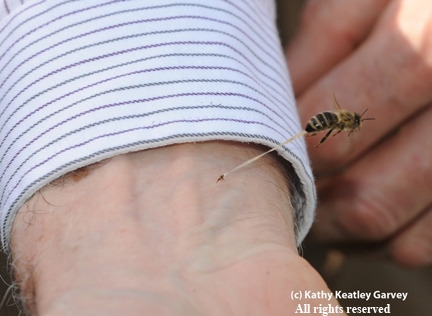
SECOND PHOTO--Honey bee pulling out abdominal tissue. This photo won the ACE feature photo award. (Copyrighted, All Rights Reserved, Photo by Kathy Keatley Garvey)
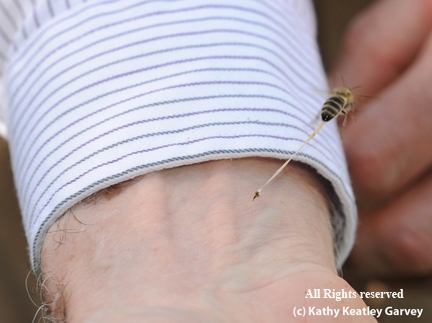
THIRD PHOTO--Honey bee trying to escape after stinging. Worker bees die after stinging, which usually occurs while they're trying to defend their hive. (Copyrighted, All Rights Reserved, Photo by Kathy Keatley Garvey)
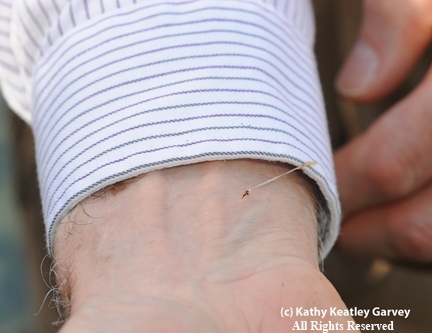
FOURTH PHOTO--A strand of abdominal tissue. (Copyrighted, All Rights Reserved, Photo by Kathy Keatley Garvey)
Show Me the Honey! (And the Wonder of Bees!)
Honey in the morningHoney in the eveningHoney at suppertimeBe my little honeyAnd love me all the time... So sang the McGuire Sisters in their 1958...
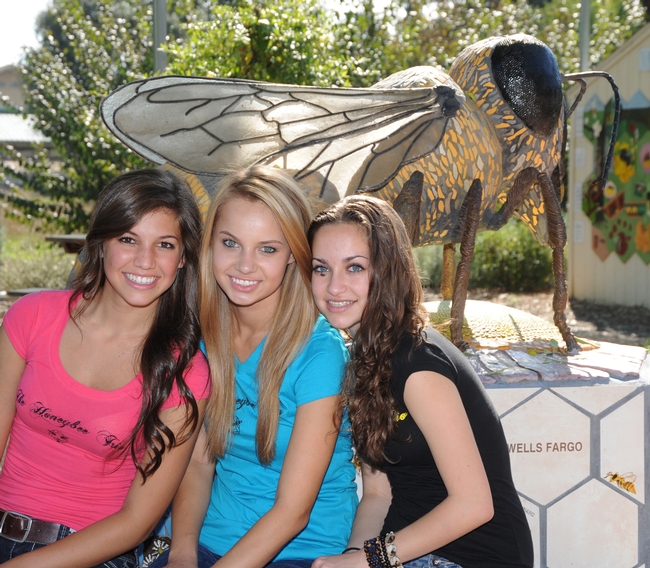
Honeybee Trio is comprised of (from left) Karli Bosler, 16; Natalie Angst, 16, and Sarah McElwain, 15. In back is Donna Billick's bee sculpture. (Photo by Kathy Keatley Garvey)
A couple of brief takes on bees
The KQED blog "News Fix" included a quick update yesterday about the California deep freeze that fizzled.
"It didn't snow in San Francisco — not really — or anywhere else near sea level late last week. Boo hoo. Let's get over it," wrote Dan Brekke.
But it was cold, so Brekke spoke to UC Cooperative Extension farm advisor Joe Connell about the effect of the cool February temperatures on California's almond crop.
Honeybees don’t like to fly in rain or freezing temperatures, Connell told him, so almond pollination has been delayed.
In other bee news, Southwest Airlines in-flight magazine Spirit highlighted a surprising fact: A bee produces just one-twelfth of a teaspoon of honey in its lifetime.
Each worker bee will fly 37,400 miles from flower to flower gathering nectar for that tiny bit of sweetener.
The queenbee's role was detailed by UC Davis honeybee expert Eric Mussen: “While the queen lays more than 1,000 eggs a day, other bees are busy feeding her, guarding the hive, and fanning the nectar with their wings to extract moisture, turning it into honey.”
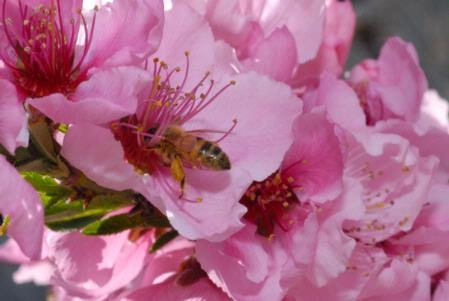
A honeybee in a nectarine blossom.

